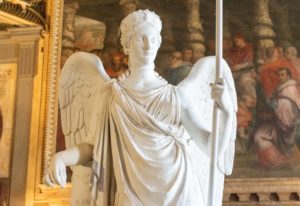‘Peace’ from Kyiv Displayed in Palazzo Vecchio

The plaster cast version of “La Pace di Kyiv”—“Peace”— by Antonio Canova, has arrived in Florence and is being exhibited at Palazzo Vecchio, in the Sala di Leone X, through September 18. The sculpture is surrounded by stories of war and peace, illustrated by frescoes depicting the life of Giovanni de’ Medici found in the room.
The cast is a plaster version of the original marble statue normally hosted by the Khanenko National Museum in Kyiv. The sculpture, however, is currently hidden for protection from possible bombing attacks as a result of the Russo-Ukrainian conflict.
The marble statue, for which the cast was created, was commissioned in 1812 by the Russian politician and diplomat Nikolai Petrovich Rumyantsev. An exponent of the the neo-classical style, Canova finished the art piece in 1815. The sculpture is perceived as a tribute to the Rumyantsev family, who were great supporters of several peace treaties between Russia and other countries.
The statue is an iconography of peace and carries a resemblance to the Greek goddess of the “Distribution of Justice”—Nemesis. The commemorative script on the sculpture are in Latin. The initial plan for the Russian language to be used was set aside in favor of Latin, the lingua franca and the symbol of the union between European nations, reinforcing the message of peace.
Vittorio Sgarbi, exhibition curator, spoke about several specific acts of war and touched upon the hostilities in the Ukraine. During his introductory remarks at the press conference in Palazzo Vecchio, images of damaged and destroyed buildings and art, were concurrently shown via a projection on the walls of the large room. At the end, he commented “Canova’s La Pace di Kyiv, is now in Florence, and here, the sculpture awaits times of peace. […] In the name of Peace, I ask you to invoke it all together on the spirit level, so that the world may be saved.” (ted de veer)
THE FOURTH ESTATE
On loan from the Museo del Novecento in Milan, ‘The Quarto Stato’ (the Fourth Estate), a painting by Pellizza da Volpedo, is also being exhibited in Palazzo Vecchio as well through June 30.
The Fourth Estate depicts a moment during a labor strike, when representatives calmly but confidently stride in before a crowd of workers, to negotiate their rights on the job. After the artist’s death (1907), the painting became a symbol for the Italian socialist viewpoint. It was later on recognized as one of the most important Italian works of art from the turn of the 20th century.

The piece was created between 1898 and 1901. Da Volpedo was a divisionist; the style is recognizable by the separation of colors into individual dots or patches which interact optically with each other. Divisionism is a subcategory within Neo-Impressionism, typically used in late 19th century art. The painting will be showcased in Palazzo Vecchio for one month and will return to its original location in Milan after that period.
